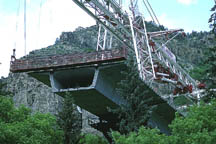STRUCTURAL ENGINEERING
Kavanagh Lecture - Abstract
April 1, 2010
Toward Crack-Free Bridge Decks
by
David Darwin
Deane E. Ackers Distinguished Professor of Civil, Environmental and Architectural Engineering and
Director of Stuctural Engineering and Materials Laboratory,
University of Kansas
ABSTRACT
It has been estimated that the direct cost of corrosion in highway bridges exceeds $8 billion per year, with indirect costs to users due to traffic delays and lost productivity equal to 10 times as much. A significant portion of these costs can be tied directly to replacement costs for bridge decks, which are damaged principally due to corrosion of reinforcing steel caused by deicing chemicals. Research has demonstrated that transverse cracks in the concrete decks provide the primary access for water and deicing chemicals to the reinforcing steel. But research over the past 40 years also provides strong guidance on how to reduce cracking in bridge decks. This knowledge is being applied in a two-phase, 11-year pooled-fund study, joined by 19 state Departments of Transportation and the Federal Highway Administration, to develop aggregate, concrete, and construction specifications for low-cracking high-performance concrete (LC-HPC) bridge decks. In Phase I, 20 bridge decks were constructed using a combination of best practices.
Techniques to reduce cracking include a reduction in the cement paste content of the concrete while maintaining workability, finishability, and pumpability through the use of optimized aggregate gradations, maintaining adequate air content, deemphasizing the importance of high compressive strength and low concrete permeability, controlling the temperature of the concrete at the time of placement, providing improved curing, and reducing the rate of drying after curing is complete. Deck construction is supported by parallel efforts in the laboratory. The background and specifications for the study are presented, along with a description of the field experience and crack survey results available from the first bridges in the study. Those surveys demonstrate that the procedures used for LC-HPC decks result in crack densities that are significantly below those observed in conventional bridge decks. Phase II of the study consists of the construction of 20 additional bridge decks, and includes the application of additional tools to reduce cracking, including the use of internal curing and shrinkage-reducing admixtures individually and in combination with supplementary cementitious materials.

